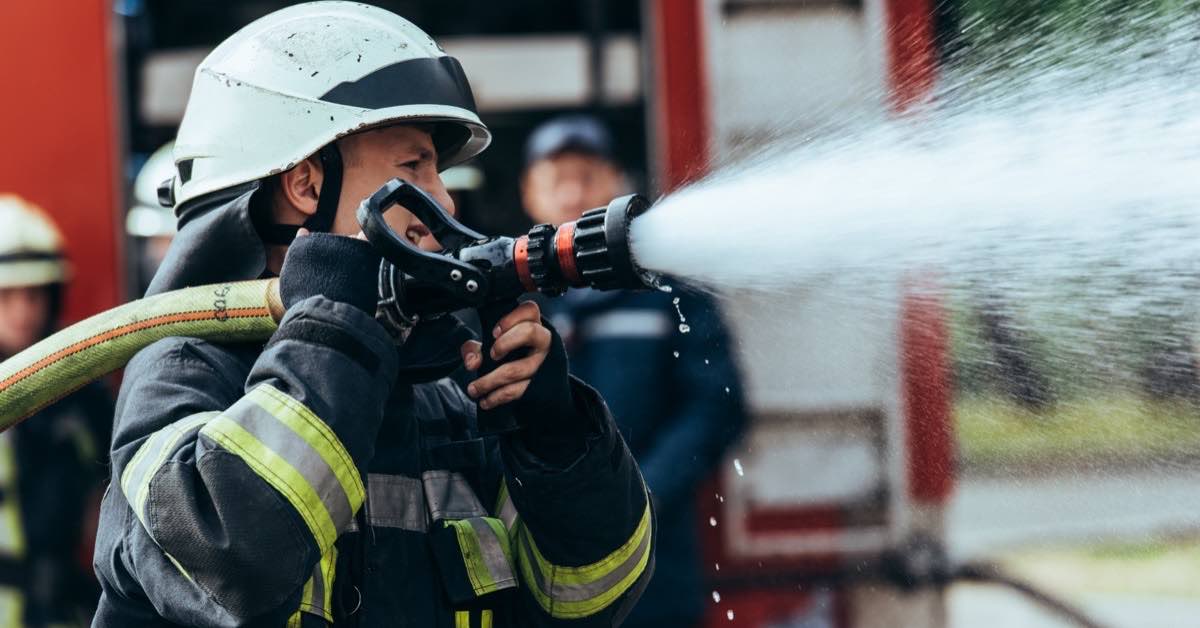Fire safety is a critical concern for apartment dwellers. With multiple units sharing the same building, the fire risk can quickly escalate, leading to devastating consequences. Every year, fires in apartments cause several injuries and deaths, making it essential for renters to understand how to prevent and respond to fire emergencies.

In the sections below, we will discuss various fire safety measures that apartment residents can take to keep themselves safe. We will also explore the common causes of apartment fires and provide tips on how tenants can minimise the risks of a fire outbreak.
Following these guidelines can ensure your safety and protect your home from potential damage in any unexpected situation.
The Importance of Fire Safety in Apartments
Firstly, fire safety is an important aspect of apartment living. Fire alarms are essential for detecting smoke and alerting residents in case of a fire outbreak.
However, false alarms can cause complacency among the residents, leading to their neglect of the system. Therefore, responding promptly to every alarm and taking all necessary precautions is crucial.
Second, tenants need to familiarise themselves with the building’s evacuation route in a fire emergency.
Knowing your escape plan can make all the difference between life and death in a panic situation where visibility may be low due to smoke or power outages.
Additionally, ensure that no obstructions on the evacuation route, such as locked doors or furniture, could impede your path.
Ensuring proper measures for fire safety in apartments can prevent property loss and lives. Therefore, it’s imperative to take necessary precautions when dealing with potential hazards by being prepared with safeguards such as familiarising with emergency procedures and responding promptly to false alarms.
Know Your Building’s Fire Safety Plan
Fire safety is a crucial aspect of apartment living, and tenants must know their building’s fire safety plan. One key area to pay attention to is electrical safety. Tenants should avoid overloading electrical outlets and using frayed cords or damaged appliances.
Additionally, they should never attempt to repair faulty wiring themselves but report it immediately to the landlord.
Everyone must know the building’s evacuation plan in case of a fire emergency. This includes knowing the location of all exits and practising evacuating safely in case of a fire. It is equally essential to be familiar with establishing smoke detectors and fire extinguishers in the building.
If a fire occurs, tenants should call triple zero (000) immediately and follow their building’s evacuation plan.
Once outside, they should stay away from the building so as not to impede firefighters working on putting out the blaze. Knowing these basic steps can help ensure that everyone stays safe during an emergency while also giving firefighters easy access to do their job effectively.
Smoke Alarms: The First Line of Defense
Smoke alarms are a crucial safety feature for any home or apartment. In the event of a fire, smoke alarms provide an early warning, giving occupants time to evacuate safely. This is particularly important in apartments where one fire may affect multiple units. Smoke alarms should be installed in every bedroom, common hallway, and apartment level.
It’s important to note that smoke alarms should also be installed on balconies or outdoor areas connected to the apartment. Balcony fires can quickly spread and become dangerous, so having a smoke alarm in this area can provide an early warning to both the occupant and neighbouring units. Additionally, occupants must test their smoke alarms regularly and replace batteries as needed.
Overall, smoke alarms serve as the first line of defence in fire safety for apartments. Taking steps such as installing them in every necessary area and conducting regular maintenance can ensure that the smoke alarms will function when needed most.
Fire Extinguishers: An Essential Tool
Fire extinguishers are an essential tool for fire safety in apartments. They are crucial for putting out small fires or stopping them from spreading until the fire department arrives.
It is important to make sure that you have the right type of extinguisher for the type of fire that may occur. For example, a Class A extinguisher is good for fires involving ordinary combustibles like wood or paper. In contrast, a Class B extinguisher is suitable for flammable liquids like gasoline or oil.
Fire extinguishers can also help restrict the spread of fire in apartments. If a small fire breaks out in one room and you have quick access to an extinguisher, you can put it out before it spreads to other rooms or units.
Additionally, having multiple extinguishers throughout the apartment complex can give residents peace of mind and increase their chances of being able to take action in case of an emergency.
Access to adequately functioning fire extinguishers is essential for ensuring apartment safety. Taking steps such as regularly inspecting and replacing old extinguishers can prevent potential disasters from occurring.
It’s important to remember that even small fires can quickly escalate into something much more significant if not dealt with promptly and correctly. Therefore, investing in quality fire safety equipment should always be a priority.
Preventing Fires with Safe Habits
One of the best ways to prevent apartment fires is to maintain safe habits. Therefore, cleaning regularly and removing any clutter that might catch fire quickly is essential. It would be best if you also avoided overloading power outlets and extension cords, which can cause electrical problems and lead to a fire. Additionally, never leave cooking appliances unattended while they’re in use.
Another way to prevent fires in your apartment is by activating any smoke detectors installed within the unit. You should test them monthly and replace their batteries at least once a year.
Furthermore, make sure you have an evacuation plan so that you know how to escape if there’s a fire emergency. Ensure every household member knows what to do during such emergencies.
Preventing fires with safe habits requires discipline and diligence from everyone living in an apartment complex. But following these simple tips can help keep yourself and your loved ones safe from harm while ensuring that your property remains intact. Consider this advice when you move into a new place, or consider revamping your safety measures for maximum protection against fire emergencies!
Evacuation Planning: Be Prepared for an Emergency
In the event of a fire in an apartment building, it is important to have a solid evacuation plan in place. One key aspect of this plan is knowing the layout of your building and identifying the nearest emergency exits. It’s also important to know where the fire alarms are located and how to use them.
If you live in a high-rise building, be sure to familiarise yourself with the various safety features that may be available, such as sprinkler systems and fire stairs. In some cases, it may be necessary to block off certain areas or stairwells during an emergency in order to contain the fire and prevent its spread.
Remember that when it comes to evacuating your apartment during an emergency, every second counts. Be prepared by planning and practising your evacuation plan regularly so that you can act quickly and confidently if necessary.
Stay Safe and Prevent Fires in Your Apartment
In conclusion, staying safe and preventing fires in your apartment is crucial for your and your neighbours’ safety. By taking simple precautions such as not overloading electrical outlets, keeping flammable materials away from heat sources, and never leaving cooking or candles unattended, you can significantly reduce the risk of a fire occurring. It’s also essential to have working smoke detectors on every level of your home and to test them regularly.
Additionally, familiarise yourself with the building’s fire safety features, including fire hose reels and extinguishers. Ensure you know where they are located and how to use them in an emergency. Finally, have an evacuation plan in place so that everyone knows what to do if there is a fire. Remember that prevention is key when it comes to fire safety in apartments. Stay vigilant and take the necessary steps to keep yourself and others safe from harm.
Useful Links for Apartment Fire Sately in Australian Apartment Buildings
Apartment Building Occupant Fire Safety
The web page is a home fire safety checklist from Victoria, Australia’s Country Fire Authority (CFA). It provides tips and precautions for preventing and responding to fires in different areas of the home, such as the kitchen, bedroom, living room, and laundry. It also has a section on preparing a bushfire survival plan and knowing the fire risk level in your area. The web page lets you select the tips you want to do right now and view them in a separate list. It also has links to other resources and contact information for emergencies.
Fire Safety in Existing Apartment Buildings
This page is published by the Department of Mines, Industry Regulation and Safety. It provides a fact sheet that explains the fire safety measures and responsibilities for high-rise apartment buildings. It mentions the Grenfell Tower fire and other fire events as examples of why fire safety is important. It also provides some sources for more information on fire safety.
Fire Protection Association Australia (FPA Australia)
This link is the home page of the Fire Protection Association Australia (FPA Australia), which is the national peak body for fire safety in Australia. It is a not-for-profit organisation that supports and represents the fire protection industry and seeks to improve community safety. It has members from various sectors and professions related to fire protection and provides information, services, and education to them and the public. It also administers accreditation and licensing schemes for fire protection practitioners and technicians. It has a strategic plan called Directions 28 that outlines its vision and goals for the future.




